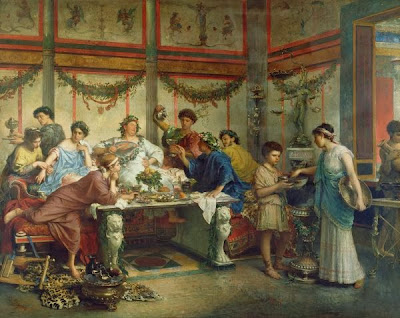By Anne Dealy, Director of Education and Public Information
 |
| Roman Feast, by Roberto Bompiani. Image courtesy the Getty. |
Although
Christmas marks an event that occurred 2000 years ago, Christmas as Americans
celebrate it today is a relatively recent invention. The origins of the modern
Christmas celebration are not found in the Bible, so much as in pagan religious
traditions and 19th-century American middle class values. Midwinter
celebrations have been part of many cultures around the world and portions of
these celebrations have been incorporated into the celebration of Christmas.
Ancient Romans celebrated Saturnalia, in honor of the god of agriculture and
the harvest, in December. The celebration included the reversal of the social
order, with masters waiting on servants, and eating, drinking and raucous
behavior. The Christian church did not institute Christmas as a holiday until
the fourth century and probably chose December 25 in an effort to Christianize
these popular pagan celebrations. As a result, pagan traditions of disorder and
misrule continued, with the poor expecting food and drink at the expense of the
rich and threatening
mischief if refused.
 |
| Traditions of wassail and mistletoe stem from pagan religious rites that predate Christianity. |
Because
of these pagan traditions of disorder and the lack of biblical evidence for
Christmas, the Puritans and other Calvinists rejected the celebration of the
holiday in the 17th century. Christmas was even outlawed in parts of
colonial New England . While some (Anglican)
Southerners celebrated the holiday with church, dinner, dancing and visiting,
it was not widely celebrated in the North until the mid-19th
century. In Geneva
 |
| Thomas Nast’s 1863 view of Santa Claus created the image Americans have used ever since. |
By
the early 1800s Christmas had become a concern to the Protestant middle class,
particularly in New York City Moore Irving
 |
| The 19th-century family surrounding the Christmas Tree. |
When
Phineas Prouty Jr. and his wife Adelaide
“Oh the excitement and wonder of this morning! The
tea set! The doll! The candy! Nuts! & cornucopias!! Little Sister has her
arms full of pretty things and looks wild at all this noise and frolic. This
afternoon I made a Christmas tree and Mill had a private tea party.”
-Adelaide
By
the 1860s Christmas was well established and closely resembled today’s holiday,
right down to complaints about commercialism. For more about the invention of
the American Christmas read Stephen Nissenbaum’s The Battle for Christmas.
No comments:
Post a Comment